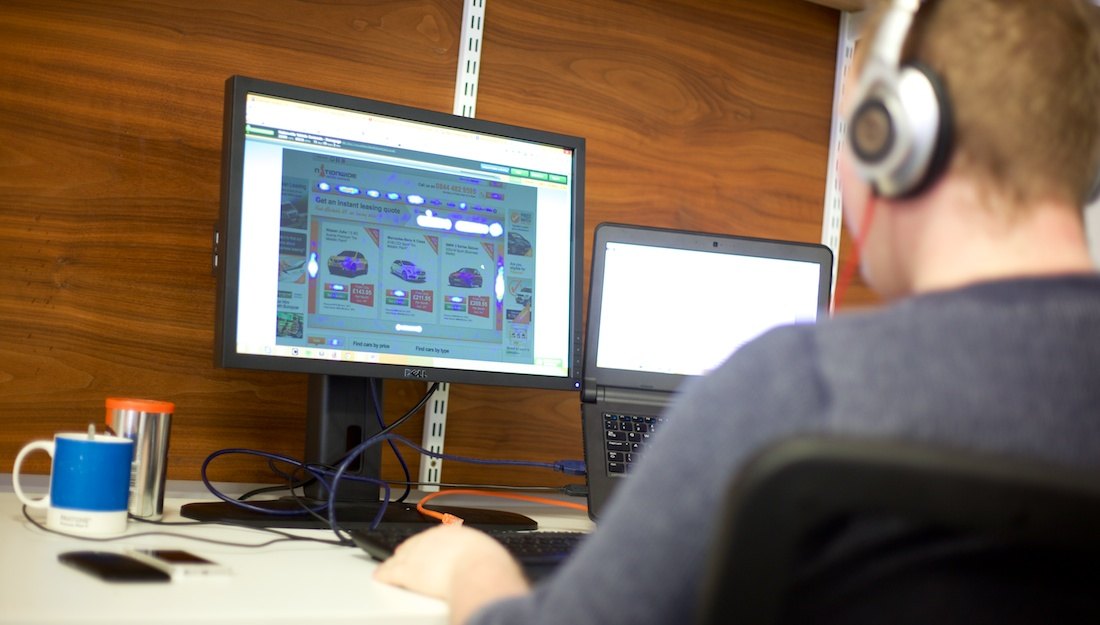Integrating CRO: How to Ensure Conversion Rate Optimisation and Content Work Together

By Luke Hay|12 Jun 2015
Content is an essential part of CRO and most A/B tests require some sort of change to onpage content. Because of this, it’s important that content creators and conversion optimisers work together to their mutual benefit. Often, both disciplines will have the same, or at least similar, objectives and both have a wealth of knowledge that can be shared.
Content plays a huge part in the success of any website; the subject needs to resonate with users and the delivery method needs to work well for them too. Content is often thought of as being the copy on a site, but it also includes video, infographics and other elements that make up webpages. An example of this would be providing infographics for users who are time poor, while providing in-depth whitepapers for those who want details.
Content plays a huge part in the CRO process. Quality content converts better, and quality targeted content converts best. Here at Fresh Egg we work closely with the content team to enhance our CRO offering and ensure that we provide great content for our experiments.
How can the two disciplines complement each other?
Great content is a large part of a positive user experience. Whether this is on a site that has some personality to its copy or a brilliant video showcasing a product, content can be a crucial factor in driving conversions.
Knowledge of users
Both content and CRO require an in-depth understanding of a website’s users. Content marketers need to know the subjects, tone, and formats that will best resonate with their users, and which stage of the buying cycle their target user is at. This gives them an understanding of what to write about and how to deliver it. CRO specialists need to understand which changes will be likely to have the most impact, based on the behaviour of users.
Shared learnings
CRO experts and content creators can learn from each other’s experiences. Learnings from A/B test results can be used to inform content creation. Data from completed tests can show what has previously proved popular with users and this can be used to plan the future content strategy.
On the other hand, successful content can be used to inform which tests are likely to have the biggest impact. If certain types of content prove popular, perhaps demonstrated by a large amount of social shares or a high number of visits, then this type of content could be included in future tests. For example, if video is proving to be a particularly popular type of content then tests could be run around including more video content on other pages of the site.
A full content audit will show what content currently works well on a site, and what types of content are missing. This can give conversion optimisers some focus areas to test on.
High quality content
Great content can lead to great A/B test results but poor content can lead to poor results. For example, if a badly shot video is used in a test to see if video is a good medium to use, it will be likely to show inconclusive or inaccurate results. It would be unfair to judge the performance of video content on the performance of a poor video. To give the best possible chance of success, high quality content is required for some tests.
Building on hypotheses
Content creators and specialists can help to make a hypothesis come to life. A hypothesis might just refer to ‘better quality copy’ and good content writers are able to provide this. Whether it’s rewriting an important page on a site, or just changing some key messages or calls to action, great copy can ensure that tests are truly reflective of the original hypothesis.
User testing
The key to a good CRO campaign is often the discovery work that takes place before any tests are started. This discovery period can include user research, industry research, competitor research and user testing. When this information is combined, it gives a real insight into the users of a website, including who they are and what they like.

Fresh Egg conversion strategist, Hans Hoogenboom, hard at work
User testing in particular can uncover content issues on a site. Getting feedback from real users can uncover issues that content teams may otherwise be unaware of. It can also lead to ideas for different types of content that is desired by the users.
Sarah Furbank, one of Fresh Egg’s content marketing specialists, says:
"The value of the insight that can be gained from user testing from a content creator’s perspective cannot be underestimated. When you’ve been working on a website for a long time, and have become so familiar with its content, generating ideas for fresh approaches can be tricky. By working with the CRO team and analysing user testing results together, a whole host of new content ideas can be generated. This could be anything from the creation of user guide videos to help people use the website, to the addition of extra FAQs to help answer the most common questions people have."
More shares and search visibility
Great content can lead to pages being shared on social media and also potentially increased search visibility for a page. This can mean a large amount of traffic, which in turn can lead to quicker results for A/B tests.
Business focus
As well as an understanding of the users, CRO and content both rely on an understanding of the business to get good results. This means looking beyond just the conversion rate, or view/shares for a piece of content, and understanding how their actions affect the overall business.
What are the challenges?
Both CRO and content are likely to impact each other in some way. While the two can work well together, the section below gives some areas to look out for to ensure the two combine and don’t conflict.
Careful scheduling
Content changes and CRO campaigns need to be scheduled together, and this may not be easy. Generally speaking, A/B tests are relatively long term and require planning and preparation time. Content changes, on the other hand, may need to be quick to be topical. While some content can be planned months in advance, other types of content may require a more agile approach, which may not be compatible with long term A/B testing.
It is also possible that the results of A/B tests may mean significant changes to a site, making a long term content plan invalid.
Giving up control
Sometimes A/B testing can mean that content creators lose some control over their content. Tests may prove that content that took a lot of effort to create is not as effective as a simpler variation. Content creators need to be aware that their variations may not win.
Conversely, CRO specialists may also have to consider more than just conversions. Some CRO campaigns suffer from focusing solely on encouraging users to convert as quickly as possible. The purpose of content, however, is not always to drive conversions but can instead be to improve a user’s overall perception of a brand, or to encourage social sharing. With this in mind, it should be decided at the start of a test what the intended outcome is, and how this should be measured. The metrics used by content and CRO teams are often different so a compromise may need to be made when it comes to measuring success.
There can also be an issue of differences of opinion. Content and CRO teams may have different approaches which can lead to conflict and misunderstanding. Content creators may be, understandably, protective over content they have worked hard on and they may not appreciate tests being run on it.
Double the work
If tests are on a large scale then it can mean a lot of additional work for content creators. Creating two variations of a great piece of content is not easy and great content takes time. It may not be practical to shoot two versions of a video to see which one users react best to, or to write copy in two different styles. The amount of work required from content creators should be a major consideration for proposed A/B tests.
Social sharing
Social sharing may be a big part of content creation but this can create issues if people are sharing a page that is part of a test that has a radically different variation. This means people could be unwittingly sharing a page that’s showing other people different content to what they read. If users are sharing a video that they liked but the variation of a page has had the video content removed then this could lead to confusion and irritation.

Also, although the additional quantity of traffic that may come via social sharing is good, the quality may have a negative impact on tests. If users are coming to the page via social shares with no intention of converting then they may skew the results of a test.
If people are sharing content because it is innovative then this may have a broad appeal, meaning that the people viewing this content may not be the core audience for the site. Even if this content is not in a key part of the site, the influx of visitors may have an impact on any sitewide tests.
Areas of focus
The aim of both content and conversion optimisation is to improve the user experience of a website. However, the two disciplines will often focus on different areas of a site. Content may focus on blogs and news sections, while CRO will generally focus on more commercial pages, such as product pages and checkouts. This can be an advantage as the two can be independent of each other, but it may mean there is less shared knowledge between them.
Summary
CRO and content make a good team. The content of a site is often the focus of CRO campaigns so it’s vital that the two disciplines work together to achieve great results. While both can have different objectives and sometimes work in different ways, the two both have a need to understand the needs and desires of a website’s users at their hearts. Conflict between the teams is likely, however, if campaigns aren’t well planned.
From a CRO perspective, initial hypotheses are just the starting point of a CRO campaign. Input from content creators will often be required to make these hypotheses a reality, and great content can contribute towards great a/b test results.
Find out more about our conversion rate optimisation and content marketing services.
